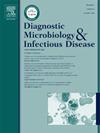Performance of a molecular beacon-based qPCR method for detection of fluoroquinolone resistance in Mycobacterium tuberculosis: A study confirmed by sequencing
IF 2.1
4区 医学
Q3 INFECTIOUS DISEASES
Diagnostic microbiology and infectious disease
Pub Date : 2025-04-22
DOI:10.1016/j.diagmicrobio.2025.116865
引用次数: 0
Abstract
Multidrug-resistant tuberculosis (MDR-TB) poses a serious threat to the control and treatment of tuberculosis (TB). Rapid diagnosis of resistant strains via utilization of molecular techniques is of critical importance on the proper management of the patients. The objective of this study was to develop a quantitative polymerase chain reaction (qPCR) method for the detection of mutation-based fluoroquinolone (FQ) resistance in Mycobacterium tuberculosis isolates. Primers and a molecular-beacon probe were designed to target quinolone-resistance-determining-region (QRDR) of the gyrA gene of M. tuberculosis. Amplification conditions and concentrations of primers/probe were optimized, and the effectiveness of the optimized qPCR method was tested on 50 MDR M. tuberculosis strains. To confirm the qPCR results, all strains were also screened for mutations in the gyrA gene using Sanger sequencing. The optimized qPCR method had analytical sensitivity of 96.5 cfu/ml. The method detected FQ resistance in 7 (14 %) of the 50 MDR-strains via either no or significantly decreased fluorescence signal due to mutations associated with FQ resistance. The sequencing of these seven strains detected three resistance-associated mutations (A90V, D94A and D94G). Of the 43 FQ-susceptible strains, 10 strains with wild-type gene sequences yielded strong fluorescent signals above 450 RFU, while the remaining 33 strains harboring a non-resistance-associated mutation (S95T) showed decreased fluorescence signals <350 RFU. The sensitivity and specificity of the qPCR method for detection of the mutations related to resistance was ≥99.9 % and 98 %, respectively. Consequently, the utility of the optimized qPCR method for the identification of mutation-based FQ resistance is promising.
基于分子信标的qPCR检测结核分枝杆菌氟喹诺酮类药物耐药性的性能:经测序证实的研究
耐多药结核病(MDR-TB)对结核病的控制和治疗构成严重威胁。利用分子技术快速诊断耐药菌株对患者的正确管理至关重要。本研究旨在建立基于突变的结核分枝杆菌氟喹诺酮(FQ)耐药性的定量聚合酶链反应(qPCR)检测方法。设计引物和分子信标探针靶向结核分枝杆菌gyrA基因的喹诺酮耐药决定区(QRDR)。优化扩增条件和引物/探针浓度,对50株耐多药结核分枝杆菌进行qPCR检测。为了确认qPCR结果,所有菌株也使用Sanger测序筛选gyrA基因突变。优化后的qPCR方法分析灵敏度为96.5 cfu/ml。该方法检测到50株耐多药菌株中有7株(14%)对FQ耐药,荧光信号不存在或因FQ耐药相关突变而显著降低。这7株菌株的测序检测到3个耐药相关突变(A90V、D94A和D94G)。43株fq敏感菌株中,野生型基因序列的10株在450rfu以上荧光信号较强,而含有非抗性相关突变(S95T)的33株在350rfu以上荧光信号较弱。qPCR检测耐药相关突变的灵敏度和特异性分别为≥99.9%和98%。因此,优化后的qPCR方法用于基于突变的FQ抗性鉴定是有希望的。
本文章由计算机程序翻译,如有差异,请以英文原文为准。
求助全文
约1分钟内获得全文
求助全文
来源期刊
CiteScore
5.30
自引率
3.40%
发文量
149
审稿时长
56 days
期刊介绍:
Diagnostic Microbiology and Infectious Disease keeps you informed of the latest developments in clinical microbiology and the diagnosis and treatment of infectious diseases. Packed with rigorously peer-reviewed articles and studies in bacteriology, immunology, immunoserology, infectious diseases, mycology, parasitology, and virology, the journal examines new procedures, unusual cases, controversial issues, and important new literature. Diagnostic Microbiology and Infectious Disease distinguished independent editorial board, consisting of experts from many medical specialties, ensures you extensive and authoritative coverage.

 求助内容:
求助内容: 应助结果提醒方式:
应助结果提醒方式:


